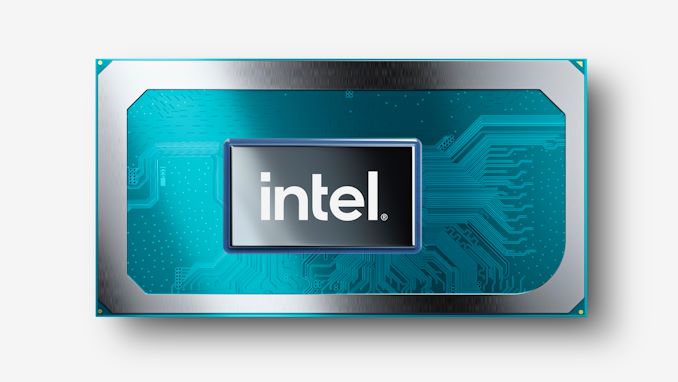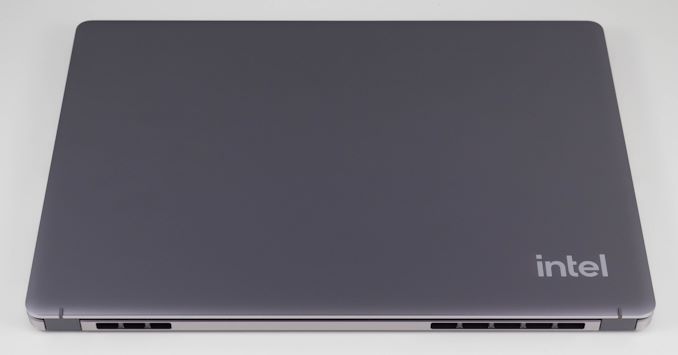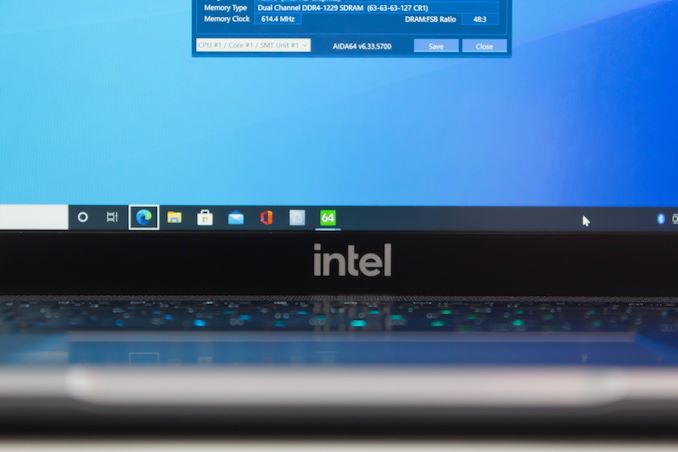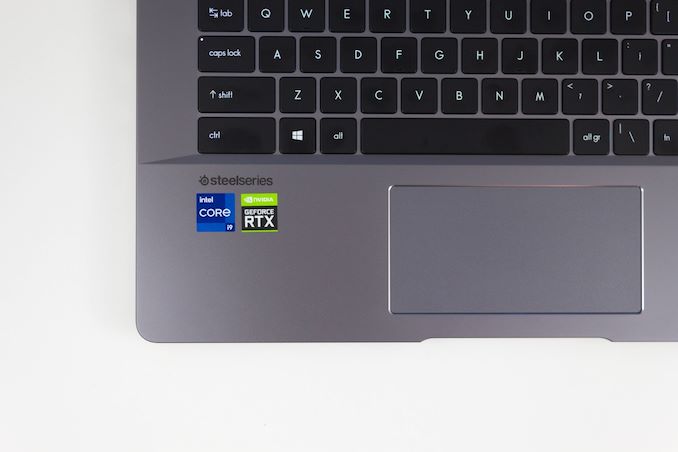Intel 11th Generation Core Tiger Lake-H Performance Review: Fast and Power Hungry
by Brett Howse & Andrei Frumusanu on May 17, 2021 9:00 AM EST- Posted in
- CPUs
- Intel
- 10nm
- Willow Cove
- SuperFin
- 11th Gen
- Tiger Lake-H

Last week Intel launched their Tiger Lake-H family of laptop processors. Aimed at the larger 14-inch and above laptops, this processor family is Intel’s newest offering for the high-performance laptop market, stepping in above Intel’s mobility-focused U and Y series of chips. Based on the same Tiger Lake architecture that we first became familiar with last year, Tiger Lake-H is bigger and better (at least where the CPU is concerned), offering up to 8 CPU cores and other benefits like additional PCIe lanes. Overall, Intel’s H-series chips have long served as the performance backbone of their laptop efforts, and with Tiger Lake-H they are looking to continue that tradition.
While last week was Tiger Lake-H’s official launch, as has become increasingly common for laptop launches, the embargoes for the launch information and for hardware reviews have landed on separate dates. So, while we were able to take about the platform last week, it’s only today that we’re able to share with you our data on TGL-H – and our evaluation on whether it lives up to Intel’s claims as well as how it stacks up to the competition.
Like Intel’s other laptop chips, Tiger Lake-H has multiple facets, with the company needing to balance CPU performance, GPU performance, and power consumption, all while ensuring it’s suitable to manufacture on Intel’s revised 10nm “SuperFin” process. Balancing all of these elements is a challenge in and of itself, never mind the fact that arch-rival AMD is looking to compete with their own Zen 3 architecture-based Ryzen 5000 Mobile (Cezanne) APUs.
| Intel Tiger Lake-H Consumer | ||||||||||
| AnandTech | Cores Threads |
35W Base |
45W Base |
65W Base |
2C Turbo |
4C Turbo |
nT Turbo |
L3 Cache |
Xe GPU |
Xe MHz |
| i9-11980HK | 8C/16T | - | 2.6 | 3.3 | 5.0* | 4.9 | 4.5 | 24 MB | 32 | 1450 |
| i9-11900H | 8C/16T | 2.1 | 2.5 | - | 4.9* | 4.8 | 4.4 | 24 MB | 32 | 1450 |
| i7-11800H | 8C/16T | 1.9 | 2.3 | - | 4.6 | 4.5 | 4.2 | 24 MB | 32 | 1450 |
| i5-11400H | 6C/12T | 2.2 | 2.7 | - | 4.5 | 4.3 | 4.1 | 12 MB | 16 | 1450 |
| i5-11260H | 6C/12T | 2.1 | 2.6 | - | 4.4 | 4.2 | 4.0 | 12 MB | 16 | 1400 |
| *Turbo Boost Max 3.0 | ||||||||||
Intel’s Reference Design Laptop: Core i9-11980HK Inside
For our Tiger Lake-H performance review, Intel has once again sent over one of their reference design laptops. As with the Tiger Lake-U launch last year, these reference design laptops are not retail laptops in and of themselves, but more of an advanced engineering sample designed to demonstrate the performance of the underlying hardware. In this specific case, the BIOS identifies that the laptop was assembled by MSI.
Wanting to put their best foot forward in terms of laptop performance, Intel’s TGL-H reference design laptop is, as you’d imagine, a rather high-end system. The 16-inch laptop is based around Intel’s best TGL-H part, the Core i9-11980HK, which offers 8 Willow Cove architecture CPU cores with SMT, for a total of 16 threads. This processor can turbo as high as 5.0GHz on its favored cores, a bit behind Intel’s previous-generation Comet Lake-H CPUs, but keeping clockspeeds close while making up the difference on IPC.
Unfortunately, their desire to put their best foot forward means that Intel has configured the CPU in this system to run at 65W, rather than the more typical 45W TDP of most high-end laptops. 65W is a valid mode for this chip, so strictly speaking Intel isn’t juicing the chip, but the bulk of the Tiger Lake-H lineup is intended to run at a more lap-friendly 45W. This gives the Intel system an innate advantage in terms of performance, since it has more TDP headroom to play with.
| Intel Reference Design: Tiger Lake-H | |
| CPU | Intel Core i9-11980HK 8 Cores, 16 Threads 2600 MHz Base (45W) 3300 MHz Base (65W) 5000 MHz Turbo 2C 4500 MHz Turbo nT |
| GPU | Integrated: Xe-LP Graphics 32 Execution Units, up to 1450 MHz Discrete: NVIDIA GeForce RTX 3060 Laptop 30 SMs, up to 1703MHz |
| DRAM | 32 GB DDR4-3200 CL22 |
| Storage | 2x OEM Phison E16 512GB SSD (NVMe PCIe 4.0 x4) |
| Display | 16-inch 2560x1600 |
| IO | 2x USB-C 2x USB-A |
| Wi-Fi | Intel AX210 Wi-Fi 6E + BT5.2 Adapter |
| Power Mode | 65 W (Mostly tested at 45W) |
Meanwhile the focus on CPU performance with TGL-H does come at a cost to integrated GPU performance. TGL-H parts include Intel’s Xe-LP GPU, but with only 32 EUs instead of the 96 found on high-end Tiger Lake-U systems. With TGL-H, Intel is expecting these systems to be bundled with discrete GPUs, so they don’t dedicate nearly as much die space to an integrated GPU that may not get used much anyhow. To that end, the reference system comes with an NVIDIA GeForce RTX 3060 Laptop graphics adapter as well, which is paired with its own 6GB of GDDR6.
Rounding out the package, the system comes with 32GB of DDR4-3200 installed. Storage is provided by a pair of Phison E16-based OEM drives, allowing Intel to show off the benefits of PCIe 4.0 connectivity for SSDs. Finally, Wi-Fi connectivity is also Intel-powered, using the company’s new AX210 adapter, which offers Wi-Fi 6E + BT5.2 on a single M.2 adapter. It’s worth noting that the AX210 is a fully discrete adapter, so it doesn’t leverage TGL-H’s integrated (CNVi) MAC, as that doesn’t support Wi-Fi 6E.
And, in keeping with making this reference system look as close to a retail design as reasonably possible, Intel even put the usual Intel Core and NVIDIA GeForce stickers on the laptop.
Unfortunately, we’ve had relatively little time with the system ahead of today’s embargo. The embargo on performance figures was originally scheduled for last Thursday (May 13th). However due to delays in shipping these laptops to reviewers, we didn’t receive the system until the end of last week, and Intel bumped back the embargo accordingly. So with just over two days to look over the system, we’ve really only had a chance to take a look at the most critical aspects of the system when it comes to performance.














229 Comments
View All Comments
gagegfg - Monday, May 17, 2021 - link
Where is the AMD "H" series? Like the 5980HX or the 5900H. It should have better multicore performance.Fulljack - Monday, May 17, 2021 - link
umm Ryzen 9 5980HS is "H" series...gagegfg - Tuesday, May 18, 2021 - link
HS <= 35WH / HX >= 45W
Linustechtips12#6900xt - Monday, May 17, 2021 - link
I find it hilarious that a desktop CPU 5600x maybe even the 57/5800x would be about the same if not better power consumption with better performance LOL especially performance per watt lol.Yojimbo - Monday, May 17, 2021 - link
Why? It's plugged in so what's the difference?Otritus - Wednesday, May 19, 2021 - link
I would assume because desktop cpus are typically tuned for performance at the cost of efficiency, and mobile processors are tuned for efficiency at the cost of performance. Power efficiency still does matter when plugged in for cooling purposes. Tiger lake needing a lot more power to deliver equal performance means higher temperatures, louder fans, or a more expensive cooling system.mode_13h - Thursday, May 20, 2021 - link
> I would assume because desktop cpus are typically tuned for performance at the cost> of efficiency, and mobile processors are tuned for efficiency at the cost of performance.
I think we've established that the H-series processors are basically desktop chips in a BGA package.
> Tiger lake needing a lot more power to deliver equal performance means higher
> temperatures, louder fans, or a more expensive cooling system.
Yup. Loud fans are why I disabled turbo on my H-series Dell Precision laptop that I use for work. The only thing I hate more than performance bogging down is screaming fans in my face. And yes, I have used pressurized air to blast any dust and debris from the cooling channels.
Also, a better cooling system tends to add bulk and weight.
cyrusfox - Monday, May 17, 2021 - link
One spelling comment, you have "GP Us" instead of "GPUs" on the first page, I use Text to speech, easy to catch it with that. Sorry to be the spelling guy. Thanks!cyrusfox - Monday, May 17, 2021 - link
Also on the last page should be"Where things aren't" not
"Where things are quite as straightforward, is the multi-threaded performance, as this is where we have to mention TDPs, power limits, and just the result of the Intel reference platform laptop we’ve tested today."
Thank you for the indepth review! Interesting stop gap to Alder lake, With apple in the market with a pending M2, going to be a very interesting space to watch.
Linustechtips12#6900xt - Monday, May 17, 2021 - link
Just wondering but could there be a comparison to an AMD 5800x or something like that just to put an idea on the power draw for the performance/ performance per watt? I was kinda curious after reading through the article a couple of times.